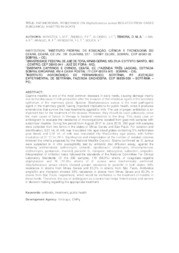Antimicrobial resistance on Staphylococcus aureus isolated from cases subclinical mastitis in goats.
Antimicrobial resistance on Staphylococcus aureus isolated from cases subclinical mastitis in goats.
Author(s): MENEZES, L. M. F; ÂNGELO, F. F.; ALCINDO, J. F.; SÁ, D. M. A.; LIMA, A. R.; ARAUJO, R. F.; MESQUITA, F. L. T.; SOUZA, V. de
Summary: Caprine mastitis is one of the most common diseases in dairy herds, causing damage mainly due to the decrease in milk production after the invasion of the infectious agent in the secretory epithelium of the mammary gland. Species Staphylococcus aureus is the most pathogenic agent in the mammary gland, having important implications for public health, since it produces enterotoxins that survive the heat treatments applied to milk. The use of proper antibiotics is an important tool for the treatment of the disease. However, they should be used judiciously, since the main cause of failure in therapy is bacterial resistance to the drug. This study uses an antibiogram to evaluate the resistance of microorganisms isolated from goat milk samples with subclinical mastitis. Antibiotics ampicillin and rifampicin showed 50% resistance in strains from Minas Gerais and 83.3% in strains from São Paulo, respectively, which would be ineffective in the treatment of mastitis in these herds. Therefore, the use of antibiogram as a control tool helps Veterinarians and owners in decision making regarding the appropriate treatment.
Publication year: 2019
Types of publication: Abstract in annals or event proceedings
Unit: Embrapa Goats & Sheep
Observation
Some of Embrapa's publications are published as ePub files. To read them, use or download one of the following free software options to your computer or mobile device. Android: Google Play Books; IOS: iBooks; Windows and Linux: Calibre.
Access other publications
Access the Agricultural Research Database (BDPA) to consult Embrapa's full library collection and records.
Visit Embrapa Bookstore to purchase books and other publications sold by Embrapa.

